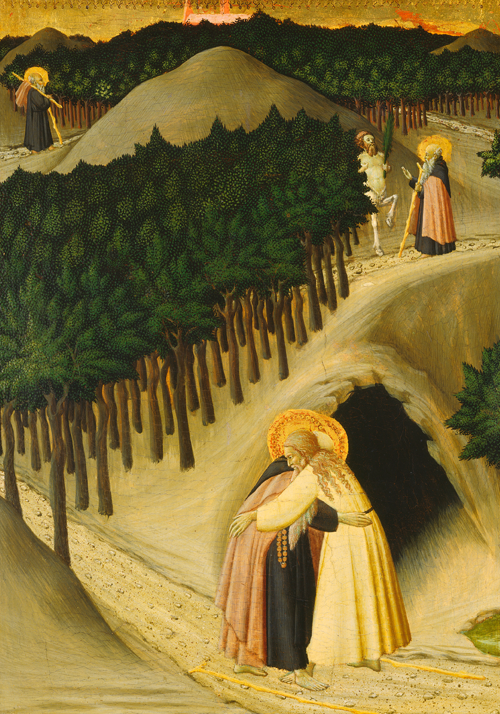
I grew up in rural Ireland in the 1950s in a world surrounded by trees.
Close to my home, a ribbon of horse chestnuts lined both sides of the road. Each summer their intertwining canopies shut out the light, which gave the road its name— the dark road. In the fields around our house there were stands of oak, birch, elm, and sycamore. About 40 yards to the south and west, my father planted a shelter belt of Leylandii. We had different varieties of apple trees in the orchard, and two pear trees.
In 1962, just as the Second Vatican Council was beginning, I entered St. Columban’s seminary to be a priest. The seminary was located on a large estate called Dowdstown in County Meath. More than 150 acres were covered in woodlands full of indigenous trees such as oak, hazel, holly, ash, Scotch pine, willow, elm, and rowan. There were also exotic species, including a number of the sturdy cedars of Lebanon, a variety of cherry trees, and even a few California redwoods. The folklore in the area was that the trees had been planted in the 1820s by General Robert Taylor, who had fought alongside Wellington at the Battle of Waterloo.
Trees are the dominant life form on land—and the longest-lived creatures on earth. During my seven years in seminary, while studying philosophy, theology, spirituality, and scripture, we never once looked to the natural world or trees for insight into our relationship with God, other human beings, or other species. And there is so much to learn! Sadly, theology and scripture presentations were isolated almost exclusively to the divine-human relationship, with little consideration given to the rest of creation.
This is due in part to the legacy of the early church fathers, who elaborated their theology of creation in the context of the prevailing teaching of Gnosticism and Manichaeism, both of which tended to despise the material world and basic bodily functions. As a result, at seminary in County Meath in the early 1960s, the woodlands were out of bounds for the students. We were not encouraged to give trees the basic respect of learning their names. (Little has changed in the intervening four decades in churches, seminaries, or divinity schools.)
The Bible, on the other hand, is replete with a theology of trees and the environment. In chapter 15 of his gospel, John presents Jesus as the true vine: “I am the true vine, and my Abba is the vine grower” (John 15:1). The believers are the branches, but they cannot bear fruit unless they are joined to and sustained by the vine tree. “Just as the branch cannot bear fruit by itself unless it abides in the vine, neither can you unless you abide in me. I am the vine, you are the branches” (John 15:4-5). The author of John’s gospel makes it very clear that the dynamic relationship between the trunk and the branches is an apt metaphor for the active, engaging relationship between Christ and the believer.
The vine and branches also instruct us on the dynamic relationships in our world. There is no good fruit if the vine and roots are damaged or severed. The devastating, interconnected effects of climate change reveal this in the most catastrophic ways.

In 2012 and 2013, the Philippines was hit by two super typhoons—Bopha and Haiyan. More than 7,000 people died. Homes, schools, roads, and other vital infrastructures were destroyed. What is forgotten is the long-term damage that typhoons do to the environment when tree cover is removed. A study carried out in Central America in the 1980s showed that a single rainstorm can dislodge up to 150,000 kilograms (331,000 pounds) of top soil from one hectare (2½ acres) of hillside once the trees have been cut. The comparable figure from a forested hillside is a mere 44 kilograms.
Intact forests regulate water run-off and thus mitigate the risks of flooding and droughts. Conversely, the destruction of forests also impacts rainfall. Cutting trees leads to a reduction in evaporation and transpiration that in turn leads to less rainfall. On hydrological grounds alone, protecting forests is essential for the future of food production.
In scripture, trees set the moral and religious context for the lives of both the individual believer and the community. For example, many of the majestic cedars of Lebanon grew to a height of 120 feet and often lived for more than 1,000 years. The long life and erect stance of cedars represented a symbolic challenge for humans. For the psalmist, “the righteous flourish like the palm tree, and grow like a cedar of Lebanon. They are planted in the house of the Lord; they flourish in the courts of our God. In old age, they still produce fruit; they are always green and full of sap showing that the Lord is upright” (Psalm 92:12-15).
The Bible is replete with a theology of trees and the environment.
In North America, the equivalent of the cedar of Lebanon is the California redwood. Redwoods are the tallest trees found on the planet. Some have reached heights of 360 feet. Redwoods are also among the longest-lived trees on earth. Unless disturbed, a redwood can live between 500 to 1,000 years. In 2013, researchers discovered a 2,520-year-old redwood, which beats the previous record-holder by 300 years. No wonder the Latin name for redwood, Sequoia sempervirens, means “green forever.”
Unlike their tree cousins in the tropical forests, which are devastated by climate change-related superstorms, recent research seems to confirm that the old-growth redwood forests along the California coast and in the Sierra Nevada are in a “growth spurt the likes of which has never been seen before.” The director of science for Save the Redwood League believes that this unprecedented growth is due to global warming.
So while climate change is wreaking havoc on other creatures and ecosystems, from polar bears to coral reefs, it is spurring growth in the redwood forests in California. The trunks are adding girth, report the scientists, and storing large amounts of carbon dioxide. Our sequoia elders are compensating for extremely high atmospheric carbon levels, but they are also preparing for a long, hot, dry millennium that will be climactically adverse to fostering seedlings, laying in now as much growth as possible.
What do the trees know that we have yet to learn? Trees stand at the hub of communities. Community is at the heart of the Christian message, from our belief in the nature of a Trinitarian God to our understanding of the communal dimension of human flourishing, and to our current understanding that all life on earth is connected and interdependent. The oak trees here at St. Columban’s support about 300 other forms of life. The numbers in the tropical forests are beyond our wildest dreams. Harvard University entomologist Edward O. Wilson described “a single leguminous tree” in the Tambopata Reserve in Peru that had in it 43 species of ants belonging to 26 genera.
Theology presentations were isolated to the divine-human relationship, with little consideration given to the rest of creation.
During the past decade, redwood researchers from Humboldt State University in northern California have made some remarkable discoveries about the community of life in the stands of old-growth forests. Climbing more than 300 feet up into the canopy of ancient redwood forests, the researchers have found a complete ecosystem of birds, bugs, salamanders, ferns, shrubs, and whole trees, growing high up in and above the fog belt. These upper-forest “epiphytes” include many fern species, and such trees and shrubs as tanbark oak, California bay, cascara buckthorn, Sitka spruce, Douglas fir, and Western hemlock. A whole ecosystem lives in the tree canopy! My understanding of the nature of the church and of Christian community would have been enhanced if I, and my teachers, had paid more attention to the world of trees during our discussions.
If contemporary Christian communities could see ourselves as part of the wider community of life, then it would help shape our ethical, political, and economic consensus to guide human interaction with trees, forests, and the wider natural world, which would lead to a mutually enhancing relationship between humans and the rest of creation, instead of the predatory relationship that is now in place.
Various Christian churches are only now beginning to take the global environmental crisis more seriously. During the 1980s, the World Council of Churches adopted the Justice, Peace, and Integrity of Creation (JPIC) ministry. Meetings were held in a variety of countries and continents culminating in the March 1990 meeting in Seoul, Korea. The Catholic Church has been somewhat slower in responding to the crisis. Even though the environment is mentioned in a number of social encyclicals such as Sollicitudo Rei Socialis (“The Concern of the Church for the Social Order,” 1987), the first document devoted exclusively to addressing the ecological issue was announced by Pope John Paul II on World Peace Day in January 1990, titled “Peace with God the Creator, Peace with All Creation.”
It is obvious that Pope Francis is very concerned about the deteriorating ecological situation right across the globe. In his inaugural homily in March 2013, he appealed to all who have positions of responsibility in economic, political, and social life, and all people of goodwill: “Let us be ‘protectors’ of creation, protectors of God’s plan inscribed in nature, protectors of one another and of the environment. Let us not allow omens of destruction and death to accompany the advance of this world!”
In Evangelii Gaudium (“The Joy of the Gospel”), which many people see as the blueprint for Pope Francis’ ministry, he cites and “makes his own” the touching and prophetic lament voiced some years ago by the bishops of the Philippines:
“An incredible variety of insects lived in the forests and were busy with all kinds of tasks…Birds flew through the air, their bright plumes and varying calls adding color and song to the green of the forests…God intended this land for us, [God’s] special creatures, but not so that we might destroy it and turn it into a wasteland…After a single night’s rain, look at the chocolate brown rivers in your locality and remember that they are carrying the life blood of the land into the sea…How can fish swim in running sewers like the Pasig [in Manila] and so many more rivers that we have polluted? Who has turned the wonderworld of the seas into underwater cemeteries bereft of color and life?”
Many commentators believe that Pope Francis soon will issue an encyclical on God’s creation, climate change, and the role of the human in the sanctity of creation. Hopefully, such a document will help the Christian community around the world see itself as part of the wider community of life, encouraging us to celebrate the beauty and wonders of forests and trees with poets, musicians, and other artists. Only then will Christians develop mutually enhancing relationships between humanity and the rest of creation.
Photo: Drop of Light / Shutterstock
This essay is reprinted with permission from Sojourners magazine, www.sojourners.net.







